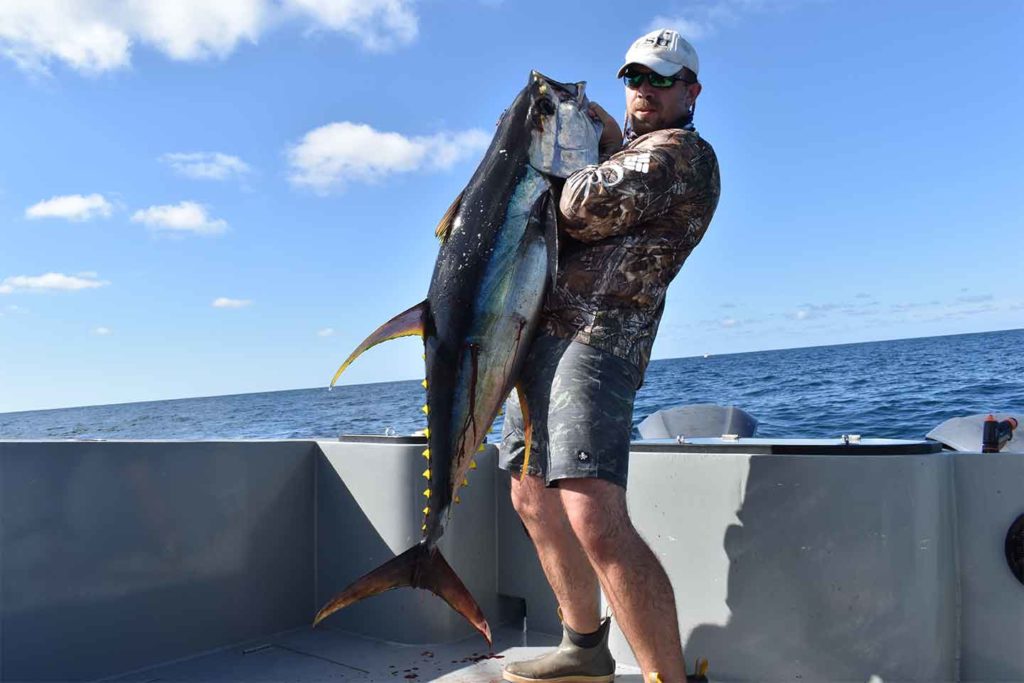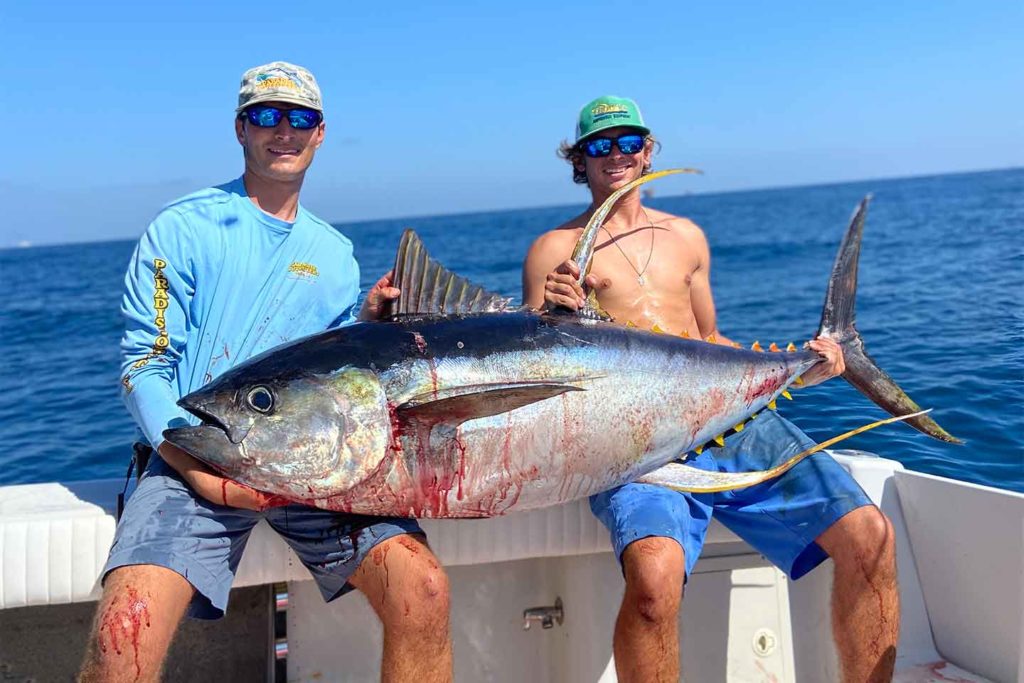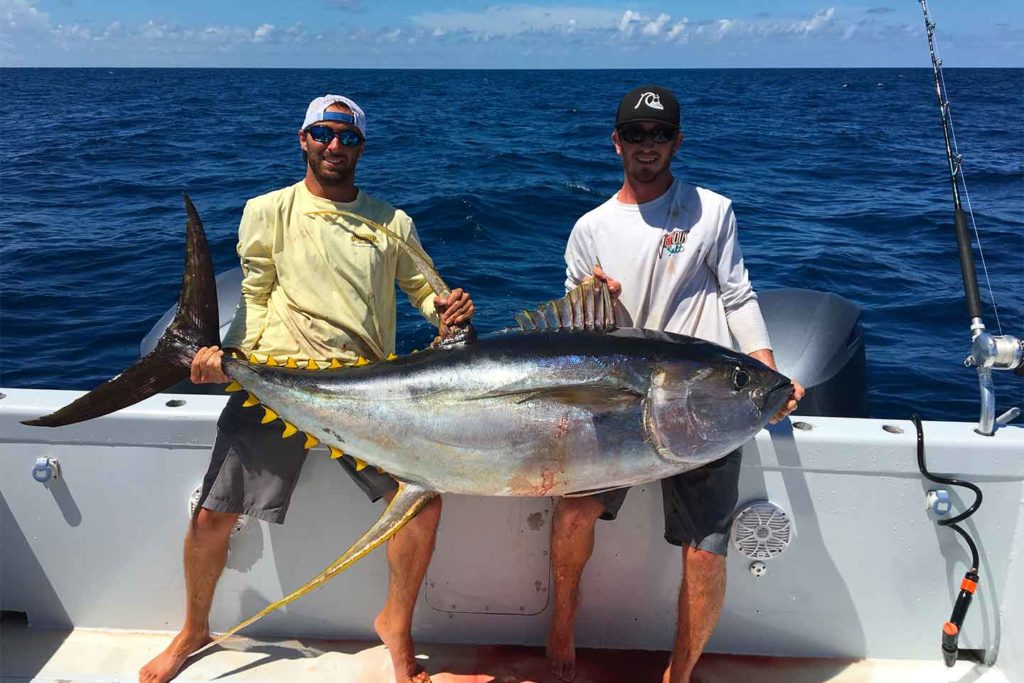CALL the CAPTAIN
Tuna fishing in Venice, LA is an experience unlike any other. You would be hard-pressed to find another destination in the world that will provide you with a more fantastic opportunity to catch yellowfin, blackfin, and bluefin tuna year-round. So prepare for battle and expect to test your might on a deep-sea tuna fishing charter with Paradise Outfitters.
The tuna species is a sleek fish built for speed. The warm-blooded fish travel in schools and don’t give up when you hook one. In fact, it is not uncommon for it take an hour to get a tuna into the boat. Deep-sea tuna fishing is a challenge in and of itself as these fish fight hard for their freedom and is unwavering in their endurance. It is a real test of strength and endurance.
From Venice to the tuna fishing grounds is about a 25-minute boat ride.


Often, customers ask about catching yellowfin tuna. The blue waters south of Venice, LA offers the opportunity to reel in a variety of tuna species. Not to mention, doing battle with other big game species, such as swordfish, marlin, and tarpon.
The most common types of tuna that you can expect to catch in Venice are yellowfin, blackfin, and bluefin tuna. While you may not catch all of these tuna species in one full-day charter, you can expect an experience that you’ll remember for a lifetime.
Year-round, anglers travel from all over the United States to fish the blue waters south of Louisiana to catch tuna. Venice, Louisiana is one of the top destinations in the world to catch Yellowfin Tuna, giving it the nickname Tuna Town.
We encourage you to book a trip to fish the Midnight Lump. Generally, the Midnight Lump is best to fish January through March.
Our custom-built charter fishing boats provide a safe, comfortable, top-notch fishing trip for your group.
Most yellowfin tuna caught in Venice, LA are between 20 and 60lbs, but larger fish come into the area in the winter and fall months. Captain Scott Leger of Paradise Outfitters holds the current Louisiana State Record for Yellowfin Tuna – 240lbs. Captain Leger is a tremendously experienced fishing guide at honing in on these giant fish with precision.
Yellowfin tuna is a species of albacore and is also known as the “ahi” fish. It is one of the largest tuna species, in some cases weighing in at over 350 pounds, the same size as an Atlantic bluefin tuna. Although yellowfin is not the largest tuna, it is reputable for its incredible strength, rivaling the leviathan Pacific Blue Fin tunas, reaching 1,000 pounds.
Yellowfin Tuna is a fast and powerful fish found anywhere from the Gulf of Mexico to Hawaii, often traveling in large schools close to the surface where they hunt actively for food. Deep-sea fishing for yellowfin tuna in Venice, LA, has proven to be a great time!

Casting topwater lures to tunas that are aggressively feeding on the surface is an unparalleled thrill in the world of sport-fishing. Tuna’s which actively feed on surface baits are ferociously powerful. This fishing style requires long-distance casting and rapid retrieval of large lures – making use of heavy-duty spinning tackle which can withstand immense pressure. Many tunas caught at the surface weigh in excess of 100 lbs. Watching tunas breach the surface and launch several feet into the air is an incredible experience.
The traditional style of creating a “chum line” of chunk baits is commonly used around oil rigs, pumping stations, and drillships to attract tunas. Essentially, this is “handlining” for tunas, which requires the angler to pull 3 to 4-foot segments of line off the reel at a time, allowing the rigged bait to float with the current. This technique requires some practice but is incredibly effective when fish are feeding in the top level of the water column.
Tried and true, trolling for tunas requires deploying artificial or rigged dead baits and dragging them behind the boat. This can be a highly effective method for enticing large tunas to bite but is usually not employed when fishing around oil rigs or pumping stations. Occasionally, slow trolling live baits that are specially bridled can produce bites when tunas are not actively feeding.
This is the preferred method for catching larger tunas. Mullet, pogies, threadfin herring, hardtails, and small tunas are exceptional live baits when properly rigged. There is no more effective technique to entice a tuna to feed than by presenting a frisky live bait at the surface. Catching live bait, depending on the time of year, can be a “must” before heading offshore.
The most physically demanding of all fishing techniques, vertical jigging requires the use of heavy lead jigs that are specifically designed to sink fast and reach fish several hundred feet down. The angler must rapidly retrieve the jig while creating a “fluttering” motion with the rod – this mimics the behavior of a bait fish fleeing to the surface. Vertical Jigging can be the most effective method for catching fish that are holding tight to structure, deep beneath the waves.
Tuna are a highly migratory species that travels to find food. Tunas can be found near pumping stations, floating oil rigs, and patrolling the open ocean for schools of bait.
There are several tuna seasons in Venice, LA. However, Venice is a year-round fishery. The best time to catch a giant tuna is early fall and early spring are considered


Send a Message Now
By entering your email or booking a trip, you agree to receive Paradise Outfitters emails, including marketing emails, and agree to our Terms & Conditions and Privacy Policy.
By entering your email or booking a trip, you agree to receive Paradise Outfitters emails, including marketing emails, and agree to our Terms & Conditions and Privacy Policy.